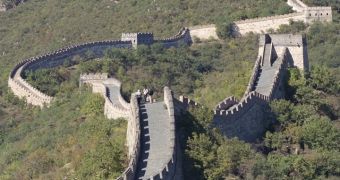1. The Han Chinese form the largest ethnic group in the world, 14 % of the planet's population. The cradle of the Chinese civilization was the valley of Huang He (Yellow River). The capital of three great Chinese dynasties: Chu (1,122-256 BC), Han (206 BC-220 AD) and Tang (618-906), was located in the city of Jinan, on the banks of Huang He, in the province of Shaanxi; then, under the dynasties of Yuang, Ming and Ching, Beijing turned into the residence of the emperor and of the high dignitaries. During all its history, China was menaced by the imminent invasion of the barbarian people of the North; the rest of the territory was inexpugnable: to the southwest, it was protected by the Tibetan plateau and the Himalaya chain, the jungle isolated it from the southeastern Asia, and the sea protected it against any danger from the east.
Starting with 1,000 BC, Chinese rulers had to face northern invasions which, by 700 BC, materialized with the penetration of the Huns and the attack of the Jung tribes from the northwest. These attacks forced the Chu emperors to move their capital to Loyang. Starting with the 3rd century BC, the powerful kingdom of Yen, located in the Beijing area, took the initiative of raising an enormous wall to defend its lands against the barbarian invasions. The Yen kings were defeated by the founder of the Tsin dynasty, who started the unification of China from 246 to 207 BC. By those times, the construction of the still standing wall started. The wall did not impede the Mongol chief Genghis Khan to conquer China in 1215. During the Chinese rule of his successor, Kublai Khan, in 1275, the famous traveler Marco Polo visited China. But the court of Kublai had nothing to do with the Mongol coarseness.
2. Beijing was made of 3 main enclosures: the External City, a place opened to all social classes, where markets and popular acts took place; the Inner City, reserved for the court, and the Forbidden City, private domain of the emperor. Each enclosure was surrounded by walls and had large gates Outside Beijing, there were thermal springs, temples, summer palaces, racetracks, enormous statues of Buddha and tombs of the emperors.
3. The Chinese art is colorful, complicated and patiently executed with miniatures, all reflected in porcelains, sculptures, paintings and furniture. Porcelain was a Chinese monopoly for long, and porcelain dishes from the Sung dynasty (10th to 12th centuries) and Ming dynasty (14th to 17th centuries) are the most famous. By the 17th century, complicated cups, bowls and vases were made of very fine porcelains, called "eggshells", almost transparent and very shiny.
4. The Han Chinese appeared in the Tibet area (their language is related to the Tibetan) and, about 5,000 years ago started to displace other tribes from modern Eastern China, many speaking Hmong-Mien, Thai and Tibetan-related languages. In fact, even today southern China is home to various minorities from these groups, and, from a historical point of view, modern western and northern China was not Chinese at all. Moreover, various Turkic, Mongol and Tungus (including Manchurian) invasions influenced the Chinese racial type.
There is a mix of racial types in what we call Chinese, and there is a clear tendency towards a bigger height and lighter skin from the south towards the north. The Chinese also have not so almond-like, Mongoloid eyes as the Mongols, for example.
5. Due to the cultivation of rice, the world's oldest crop, Chinese could feed large populations, easily overcoming in number the surrounding hunter-gatherer groups. Why was rice cultivation such an advantage? It allowed an earlier weaning of the children and this way women could get pregnant more rapidly (hormones that favor lactation impedes pregnancy). At the same time, for a nomad population of hunter-gatherers, having too many children at a time posed a problem and a sedentary group of farmers could not be confronted to such an issue.
Larger families meant more cultivated rice paddies and the process went on, causing a population boom. This also led to the decrease of the territory used by hunter-gatherers to achieve food. Farming societies could also support large armies and were immune to diseases originated in and carried by domestic animals. The Chinese made advanced agriculture, using the plow, animal power and fertilizers. Splendid terraces were made for rice cultivation. Rice produces large crops, but requires multiple cares: transplanting the seedlings, weeding, periodic irrigation.
6. The Chinese and many people of south-eastern Asia are not fond of milk and alcohol. The intolerance to milk is caused by the lack in the adult stage of the enzyme lactase that breaks down the sugar lactose from milk. When it reaches the thick intestine, bacterial decomposition of the lactose induces digestive issues.
This is due to the fact that cattle and sheep growth has been ignored along the millennia by the Chinese (perhaps because in the center of their civilization, southern/eastern China, pastures are scarce), and as far as evolution goes, individuals adapted to milk consumption were not selected. In Africa, Europe and western Asia, where milk entered the human diet from 10-5,000 years ago, the lactase is active in most adults.
7. In coastal areas, the Chinese dedicated to fishing and trade. Junks were seagoing ships having square sails spread by battens, a high stern, and usually a flat bottom. Some boats were used as houses.
8. All social classes participated in ritual processions, like that to the temple of the Good Year, assisted by the emperor. The emperor assisted also at festivities of the winter solstice, whose mark was the Taishan Mountain, close to Beijing. Thousands of people played music instruments and the crowd moved in the night wearing numerous paper lamps. The entourage preceding the emperor was figured by various multicolor dragons. Rockets were fired on this occasion.

 14 DAY TRIAL //
14 DAY TRIAL //